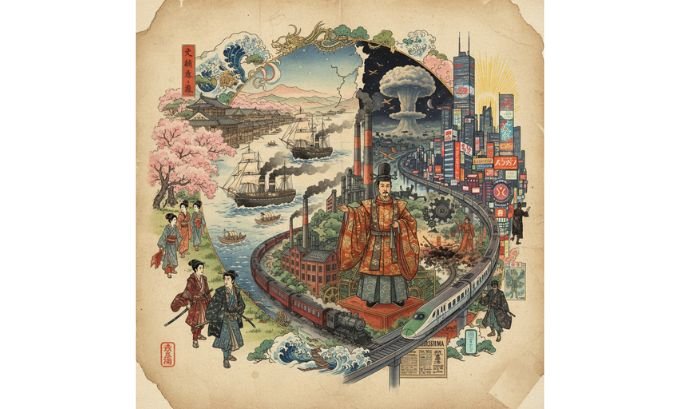Japan’s history is a captivating story of transformation, moving from centuries of deliberate isolation to becoming a global powerhouse in technology and culture. The most significant major events in Japan history include the long period of peace under the Tokugawa Shogunate, the rapid modernization of the Meiji Restoration, and the nation’s dramatic rebirth after World War II. These moments shaped not just Japan, but the course of world history.
This article explores the pivotal turning points that define Japan. We’ll examine how the country closed its borders, how it was forced open, and how it reinvented itself time and again. By understanding these key events, we gain insight into the resilience and unique character of Japanese society.
Table of Contents
The Age of the Shogun: The Tokugawa Period and Sakoku
What was the Tokugawa Shogunate? It was a period of military rule lasting from 1603 to 1868, which brought over 250 years of relative peace and stability to Japan. This era is defined by its policy of national seclusion, known as Sakoku.
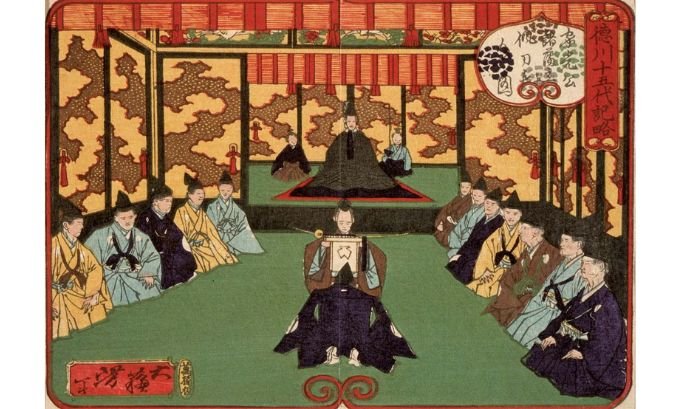
For centuries before the Tokugawa clan unified the country, Japan was plagued by civil war. Feudal lords, or daimyo, constantly fought for land and power. The Tokugawa Shogunate ended this chaos. It established a strict social hierarchy and a centralized feudal system with the shogun at the top, ruling from the new capital of Edo (modern-day Tokyo).
Personal Reflection: Understanding Sakoku in Modern Japan
When I first visited Japan, I was struck by the deep-rooted cultural etiquette and social harmony. A Japanese friend explained that many of these traits have their origins in the Edo period. He described how the Sakoku policy, which translates to “closed country,” wasn’t just about blocking trade. It was a deliberate strategy to preserve Japanese culture and prevent foreign influence, particularly Christianity, which the shogunate saw as a threat to its authority.
For over 200 years, this policy almost completely sealed Japan’s borders. The only limited trade allowed was with the Dutch and Chinese through a small man-made island in Nagasaki called Dejima. This isolation had a profound impact. It allowed a uniquely Japanese culture to flourish, from ukiyo-e woodblock prints and kabuki theater to the code of the samurai. However, it also meant that Japan fell behind the West in terms of industrial and military technology.
What I Like About the Tokugawa Period’s Legacy
- Cultural Flourishing: This long peace allowed for an incredible development of arts and culture that are still celebrated today.
- National Unity: It forged a strong sense of national identity and unity after centuries of internal conflict.
- Urban Growth: Cities like Edo grew into some of the largest in the world, fostering a vibrant urban-centric economy and culture.
Areas of Limitation
- Technological Stagnation: The Sakoku policy left Japan vulnerable to the technologically superior Western powers when they eventually arrived.
- Rigid Social Structure: Society was strictly divided into classes (samurai, farmers, artisans, merchants), which limited social mobility for generations.
The End of Isolation: Commodore Perry and the Opening of Japan
How did Japan’s isolation end? It ended abruptly in 1853 with the arrival of U.S. Commodore Matthew Perry and his fleet of “Black Ships” in Edo Bay. This event was a seismic shock to the Tokugawa Shogunate and the Japanese people.
Matthew Perry was sent by U.S. President Millard Fillmore with a clear mission: to open Japan to American trade, by force if necessary. The steam-powered, heavily armed warships were unlike anything Japan had ever seen. The shogunate, realizing their traditional defenses were no match for modern military technology, was faced with a difficult choice: capitulate or risk a devastating war.
In 1854, Perry returned, and the shogunate reluctantly signed the Treaty of Kanagawa. This treaty opened two Japanese ports to American ships for refueling and supplies and established a U.S. consulate. It was the first of several “unequal treaties” Japan would sign with Western powers, effectively ending the Sakoku policy and setting the stage for the collapse of the shogunate.
The Meiji Restoration: Japan’s Leap into the Modern World
The arrival of Matthew Perry and the signing of unequal treaties created a crisis of confidence in the Tokugawa Shogunate. Many powerful daimyo, particularly from the southern domains of Satsuma and Choshu, felt the shogun had shown weakness. This anti-government sentiment rallied around the slogan “Sonno joi” (“Revere the Emperor, Expel the Barbarians”). The goal was to restore political power to the emperor and strengthen Japan against foreign threats.
This movement culminated in the Meiji Restoration of 1868. The last shogun resigned, and power was officially returned to the young Emperor Meiji. This wasn’t just a political change; it was a radical social and economic revolution.
A Nation on a Mission: Modernization Under Emperor Meiji
Under the rule of Emperor Meiji, Japan embarked on one of the most rapid and successful modernization campaigns in world history. The new government looked to the West for models of governance, industry, and military organization.
- Political Reforms: The feudal system was abolished, and a centralized government with a constitution (promulgated in 1889) was established.
- Industrialization: Japan built railways, telegraph lines, and factories. The government sent students abroad to learn Western science and technology and hired foreign experts to advise on modernization projects.
- Military Buildup: A modern, conscripted army and navy were created, modeled after those of Prussia and Britain. This new military would soon be put to the test.
The Meiji Restoration was driven by a powerful sense of national urgency. The Japanese leadership understood that to avoid being colonized like their neighbors in Asia, they had to become a strong, modern nation themselves.
To experience a taste of Japan’s rich cultural legacy firsthand, check out Tokyo Mart for authentic Japanese food, snacks, and daily essentials.
The Rise of an Empire: Wars with China and Russia
The modernized military built during the Meiji Restoration enabled Japan to pursue its own imperial ambitions. The nation sought to secure resources and establish itself as a major power in Asia, equal to the Western colonial empires.
First Sino-Japanese War (1894-1895)
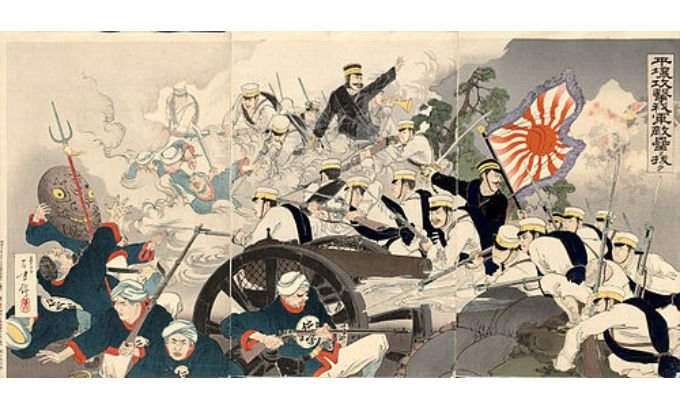
What was the Sino-Japanese War? It was a conflict fought between Japan and Qing Dynasty China, primarily over influence in Korea. Japan’s newly modernized forces achieved a swift and decisive victory, stunning the world. The Treaty of Shimonoseki, which ended the war, forced China to recognize the independence of Korea, cede Taiwan to Japan, and pay a large indemnity. This victory marked Japan’s arrival as a new imperial power.
Russo-Japanese War (1904-1905)
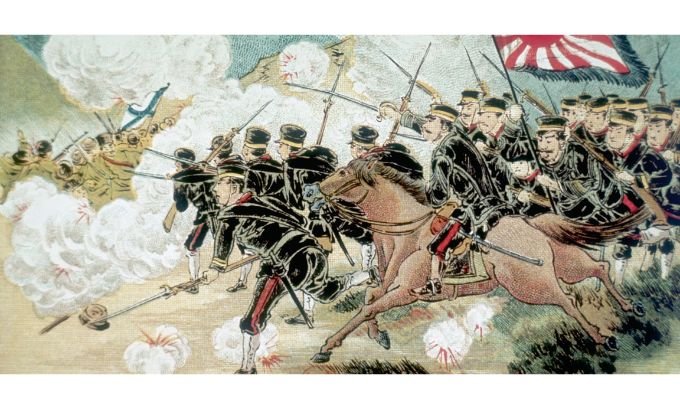
What was the Russo-Japanese War? This was a conflict born from rival imperial ambitions in Manchuria and Korea between Japan and the Russian Empire. In a historic turn of events, Japan defeated Russia, a major European power. The victory was sealed at the Battle of Tsushima, where the Japanese navy annihilated the Russian fleet.
The Russo-Japanese War was a landmark event. It was the first time in the modern era that an Asian power had defeated a Western one. This victory cemented Japan’s status as a world power and greatly bolstered its national pride, but it also fueled its expansionist and militaristic tendencies. In the aftermath, Japan formally annexed Korea in 1910.
Comparing Japan’s Major Military Victories
| Conflict | Opponent | Key Outcome | Significance |
|---|---|---|---|
| Sino-Japanese War | Qing China | Japan gains Taiwan and influence over Korea. | Establishes Japan as a regional imperial power. |
| Russo-Japanese War | Russian Empire | Japan secures control over Korea and parts of Manchuria. | First modern victory of an Asian power over a European power, boosting prestige. |
Imperial Ambitions and Global Conflict
Following its military successes, Japan continued its expansion in Asia. The nation joined the Allies in World War I, seizing German colonies in the Pacific. After the war, Japan was recognized as one of the “Big Five” powers at the Paris Peace Conference and became a founding member of the League of Nations.
However, Japan’s relationship with the West began to sour. Western powers grew wary of Japan’s ambitions in China. Racial discrimination, such as the failure to include a Racial Equality Clause in the League of Nations covenant and the U.S. Immigration Act of 1924, created deep resentment in Japan.
By the 1930s, ultranationalist and militarist factions gained control of the government. They believed that Japan’s destiny was to liberate Asia from Western colonialism and establish a “Greater East Asia Co-Prosperity Sphere.” This ideology led to the full-scale invasion of China in 1937 and eventually to a collision course with the United States.
World War II and Its Aftermath
On December 7, 1941, Japan launched a surprise attack on the U.S. naval base at Pearl Harbor, bringing the United States into World War II. For the next four years, a brutal war raged across the Pacific.
Despite early victories, the tide turned against Japan. By 1945, the country was facing defeat. However, its military leadership refused to surrender, preparing for a final, bloody defense of the homeland.
Hiroshima and Nagasaki: The Atomic End to the War
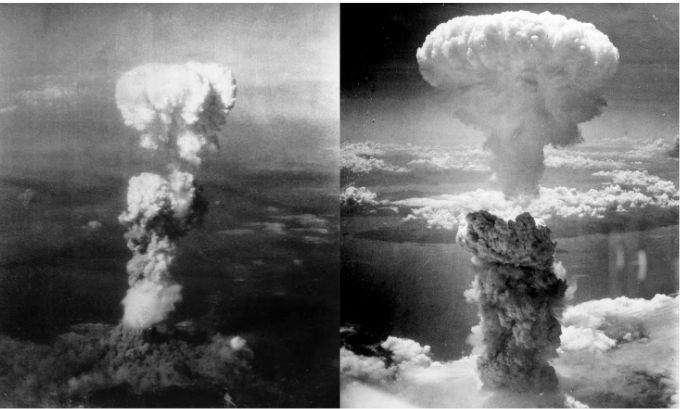
To avoid a costly ground invasion, the United States decided to use a new, devastating weapon. On August 6, 1945, an atomic bomb was dropped on the city of Hiroshima. Three days later, on August 9, a second bomb was dropped on Nagasaki. The destruction was catastrophic, killing hundreds of thousands of people instantly and in the following months.
Faced with this unprecedented power and the Soviet Union’s declaration of war, Emperor Hirohito intervened. On August 15, 1945, he announced Japan’s surrender in a radio address to the nation, an unheard-of event. The war was over.
The Occupation and Reconstruction: Douglas MacArthur’s Role
After the surrender, Japan was occupied by Allied forces under the command of U.S. General Douglas MacArthur. The goal of the occupation was not to punish Japan, but to demilitarize and democratize it.
Douglas MacArthur oversaw sweeping reforms:
- A new constitution was written, renouncing war and establishing a parliamentary democracy. The emperor was reduced to a purely ceremonial figure.
- The military was disbanded.
- Land reforms broke up large estates and gave land to tenant farmers.
- Women were granted the right to vote.
The occupation ended in 1952, but its reforms laid the foundation for Japan’s post-war recovery. With a focus on economic development rather than military power, Japan experienced an economic miracle, becoming the world’s second-largest economy by the late 1960s and a global leader in electronics and automobiles.
Frequently Asked Questions (FAQ)
1. What are the three main periods of Japanese history?
The three most defining periods are the Tokugawa Shogunate (1603-1868), a long era of peace and isolation; the Meiji Restoration (1868-1912), a time of rapid modernization; and the post-World War II era, marked by reconstruction and economic growth.
2. Who was the most important figure in Japan’s modernization?
Emperor Meiji is the symbolic head of the modernization period. While he was a powerful symbol of unity, the reforms were driven by a group of forward-thinking ministers and former samurai who led the government during the Meiji Restoration.
3. Why did Japan isolate itself during the Sakoku period?
The Tokugawa Shogunate implemented the Sakoku policy primarily to prevent the spread of Christianity, which it viewed as a destabilizing foreign influence, and to consolidate its political power without external interference.
4. How did Matthew Perry’s arrival change Japan?
Commodore Matthew Perry‘s arrival in 1853 forced Japan to end its 200-year-old isolationist policy. This triggered a period of internal turmoil that led to the collapse of the shogunate and the beginning of the Meiji Restoration, which rapidly industrialized the nation.
5. What was the significance of the Russo-Japanese War?
The Russo-Japanese War (1904-1905) was significant because it was the first time in the modern era that an Asian nation defeated a major European power. This victory established Japan as a world power but also fueled its imperial expansionism.
6. Why were Hiroshima and Nagasaki chosen as targets?
Hiroshima and Nagasaki were chosen because they were important industrial and military centers that had not been heavily damaged by previous bombing raids. The U.S. wanted to demonstrate the full power of the atomic bomb to force a quick surrender.
7. What was General Douglas MacArthur’s role after WWII?
As the Supreme Commander for the Allied Powers, Douglas MacArthur oversaw the occupation of Japan from 1945 to 1951. He implemented extensive democratic and economic reforms that were instrumental in shaping modern, post-war Japan.
Conclusion: A History of Resilience and Reinvention
The major events in Japan history tell a story of remarkable transformation. From the peaceful but isolated era of the Tokugawa Shogunate to the frenetic modernization of the Meiji Restoration and the devastating ashes of Hiroshima and Nagasaki, Japan has repeatedly reinvented itself.
Each turning point—the forced opening by Matthew Perry, the military victories in the Sino-Japanese and Russo-Japanese wars, and the democratic reforms under Douglas MacArthur—has left an indelible mark on the nation’s identity. This history of closing off, opening up, and rebuilding is essential to understanding the Japan of today: a nation that blends ancient traditions with futuristic innovation.
To learn more about this fascinating history, consider exploring the museums and historical sites in cities like Tokyo, Kyoto, and Hiroshima, where these stories come to life.

